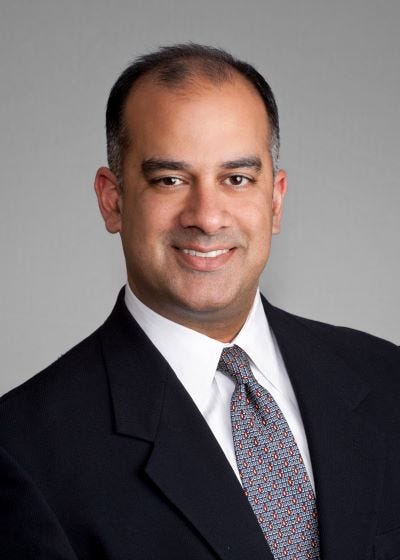Today’s CIOs move faster than their predecessors given the ever-increasing speed of business and technology innovation. In addition, what’s happening on the geopolitical stage is changing — sometimes intra-daily — creating uncertainty and complicating everything from planning and strategy to evaluation and execution.
“What we see with our clients [and] our work inside our company are things that we cannot control like tariffs and changes to decisions on countries you can and cannot operate from. [These decisions] are happening at alarming frequency with no control,” says

Niranjan Ramsunder, UST
Niranjan Ramsunder, CTO at digital transformation solutions company UST. “For example, you find that one day a decision is [made]. Next day it is rolled back. The third day it is coming back. The fourth day it is reduced in impact. Most of our clients’ approach is, ‘Let’s take a breath.’ Maybe we’ll lose some temporary margins, but there is no change of business model until we get clarity about where [the situation] stabilizes.”
Other CIOs are trying to conserve cash as much as possible because they can’t anticipate what’s coming. That can be a death sentence when it comes to smaller businesses.
Bigger companies can weather that storm for some time, Ramsunder says, adding that companies don’t change their prices quickly; they don’t change their services quickly; they don’t change their sourcing of items and services quickly, [and] they are waiting for things to happen. “So the first response to the volatility is, ‘Let us see where it ends. Let me not make any big decision right now. Let me conserve cash. Let me not do a project that completely reimagines my business and let me just see whether I can hold on [to] what I have for some more time and survive because the innovative companies burning cash are struggling.’”
Because of the current geopolitical climate, UST is being impacted by restrictions on travel visas, and there is concern about whether employees will be stopped at airports.
“All those things are day-to-day issues that are bothering us. That is addressed by let’s wait and see where it goes,” says Ramsunder.
Samir Datt, global technology strategy and architecture leader at global consulting firm Proviti, also sees hesitation among CIOs when it comes to hiring. On one hand, they want to staff up, and on the other, they’re facing a skills shortage best addressed by variable staffing. Meanwhile, they’re delaying the start date of some projects.
“As a consulting organization, we’re talking about a project that we’re going to help with, and then we’re asked to wait one more month before we start so everything is in order. And then, let’s wait a few more weeks,” says Datt. “Then we start, and there’s a pause for some reason. Similarly on technology purchases, be that a major system implementation or hardware to support it or move to the cloud. There’s that emphasis and more scrutiny on the business value. There’s [also] the question of what happens if we wait. How much longer can we continue the way we are and just see where things shake out in the market?”

Samir Datt, Proviti
During the pandemic, many organizations ran Monte Carlo simulations so they could be prepared for several different scenarios. So, instead of having a Plan B, companies had many plans (B, C, D, E, etc.). The unusually high frequency of change in 2025 is proving more difficult to navigate, however.
“Our ability to respond at speed has become the crucial differentiator,” says Ramsunder. “My biggest learning is that my organization is ready to turn on a dime and really respond quickly to those changes, [but] there’s no way I can predict and prepare and be ready, because what we’re doing may be completely different from what we have to do.”
Pandemic Lessons Learned Can Help Now
BlackLine CIO Sumit Johar says the current geopolitical situation is disrupting access to hardware, software, and skill sets, but that organizations are better prepared to navigate the current uncertainty than they were when COVID hit.
“A lot of individuals and companies that I know, are far more prepared this time than they were [during] the COVID time in terms of having the diversity of skill sets and suppliers,” says Johar. “At times I hear about laptops getting stuck at Customs or something that we ordered is taking much longer, but the diversification we built over time is allowing us to at least move things around and run our business. So far, it’s been manageable thanks to all the lessons we learned during COVID times, but you never know. Things are moving so fast, we’re just keeping fingers crossed that it does not get worse.”
When the pandemic hit, CIOs and other leaders were forced to revisit the basics of how to structure their organizations, and the lessons were clear: Organizational structure affects risk, as does the structure of partner relationships.
“You cannot have a single point of dependencies. The diversification we built in the last three or four years since COVID is helping us right now,” says Johar. “My team is far more geographically distributed than it was five years back. The same goes with my supplier landscape. I have more than one supplier for everything I do.”
Meanwhile, Blackline is constantly reevaluating in the context of today’s hyper volatility, and Johar participates in CIO councils, which he considers very important.
.jpg?width=700&auto=webp&quality=80&disable=upscale)
Sumit Johar, BlackLine
“When it comes to changing dynamics, [such as] AI and driving innovation, there are several things that people like me are dealing with right now. There is an impact on how you hire people, staffing, how to structure your organization,” says Johar. “There is an impact on risk. I’m also responsible within my organization for managing the risk of data, privacy and security, and AI is bringing a new dimension to that risk. It’s an opportunity, but it’s also a risk. How you structure your organization, how you manage risk, how you drive transformation — these things are all connected.”
The CIO’s Role Continues to Become More Important
Today’s savvy CIO is a business leader and a technology leader, which in the modern sense means increasingly taking on more of a business leadership role.
“[CIOs] are emerging as transformation leaders, so they need to understand how to navigate the culture change of an organization, the change in people in an organization. They must know how to tell stories so they can get the organization on board,” says Danielle Phaneuf, a partner, PwC cloud and digital strategy operating model leader. “Their mindset is different, so they’re embracing the transformation with a product model that allows them to move faster [and] allows them to think long term. They’re building these new muscles around change leadership and engaging the business early, co-creating solutions, not thinking they must solve everything on their own, and doing that in an agile way.”
Prior to the pandemic, digital transformation required CIOs to collaborate more effectively with the business. During the pandemic, CIOs were forced to be reactive and enable business continuity, but now more CIOs are actively tracking the business value they’re delivering, such as customer satisfaction, revenue increase, cost savings, and more.
The role of the CIO is changing based on a couple different factors, Phaneuf says. “The business environment that the CIO finds herself in is definitely a factor. What worked well when the company was stable, versus in acquisition mode or some sort of transformation, is causing the CIO to think differently, and the other leaders to think [they] need a different type of CIO for the company now or for the environment we find ourselves in. Somebody who’s good at navigating change isn’t [necessarily] good at keeping costs down or keeping the organization running efficiently.”
Having a growth mindset that values continuous learning and innovation is tantamount to success.
“We talk about CIOs being talent magnets, but especially in those organizations where it may not be as prominent as, say, an engineering organization in a tech company, building an attractive culture for high potential digital talent, leading diverse, high performing teams and being able to say, ‘An IT career can be really impactful, because we’re driving the business forward,” says Phaneuf.
Storytelling is important, and being able to demonstrate the business impact of technology, not just talking about technical ROI or technical capabilities, and telling stories in business terms, Phaneuf adds. The obvious one is being adaptive and comfortable change leading through ambiguity, being able to pivot quickly.
.jpg?width=700&auto=webp&quality=80&disable=upscale)
Danielle Phaneuf, PwC
Focusing on business value helps CIOs decide which tech investments will enable it.
“Broadly, [CIOs] are faced with a tech modernization challenge that could be anywhere in the stack, from your basic kind of underlying architecture and infrastructure to the applications,” says Phaneuf. “What they have to do is focus and start with a kind of value optimization. What are the assets we need to purchase to enable modernization that is tied to immediate near-term business value? I think it’s very cautious spending right now.”
CIOs have always been cautious about spending, though Proviti’s Datt says the tariffs and geopolitical environment are causing a ripple effect.
“Ultimately any business has to scale its output to the markets, and in turn, CIOs are faced with how much our correlated investment in technology is to meet those requirements?” says Datt.
A few things CIOs should be doing in the face of unbridled uncertainty are proactive risk management, collaborating with business leaders, being transparent and structuring regular communications at the appropriate level for different stakeholders.
“It’s important to really think through the risks to our success associated with economic volatility. So if the market crashes or [spikes] you know the effect on [the company] and contingency plans. Being nimble and being able to scale capacity up or down [is critical],” says Datt. “You need to have your cost model aligned, too.”
More broadly, business leaders want explicit confirmation that tech purchases align with their business objectives. In addition, CIOs must be proactive when there are sudden market changes that may impact the business or business model.
“It’s important to tell [the stakeholders] depending on your business model what we’re facing, how we’re managing through it and why you’re doing it the way we’re doing it,” says Datt. “This is key.”


